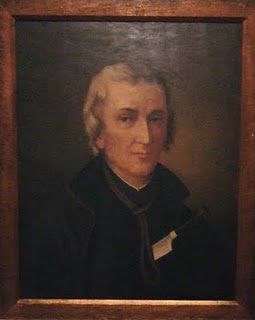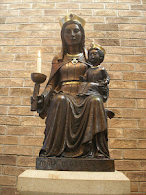 In England during Penal Times, because of the importance of the Mass, the necessity of the priesthood to the Catholic Faith was recognized by both the Church and by its enemies in Parliament. As one writer put it: “If the ‘head’ of priesthood could be severed, then the ‘body’ of Catholicism would die.”
In England during Penal Times, because of the importance of the Mass, the necessity of the priesthood to the Catholic Faith was recognized by both the Church and by its enemies in Parliament. As one writer put it: “If the ‘head’ of priesthood could be severed, then the ‘body’ of Catholicism would die.”As we know, the penalties for priesthood were severe. The Church, therefore, sought to offset government actions by establishing seminaries abroad and by developing a covert network of clergy to meet the needs of those who clung to ‘yr hen ffydd’ (the old faith). ‘Priest Hides’ or ‘Priest Holes’ became a necessary feature in the continuance of the work of priests.
All over the country, such hiding places existed. Even today, because they were so well concealed, priest holes are still being discovered. These finds often take place when repairs, restoration, or demolition work is being carried out on old houses. Excellent examples of priest holes can be seen at such places as the Bar Convent in York and at Harvington Hall in Kidderminster.
The most famous builder of priest holes was Nicholas Owen who was a carpenter and one of the first Jesuit lay brothers. The danger of betrayal was ever present so, for this reason, Nicholas always worked alone and at night. Before beginning a new job, Nicholas would spend time in prayer. He was so good at his craft that when he was arrested, the Secretary of State, Cecil, wrote: “It is incredible how great was the joy caused by his arrest…knowing the great skill of Owen in constructing hiding places, and the innumerable qualities of dark holes which he had schemed for hiding priests all through England.”
Owen was tortured to death in the Tower of London in 1606 but revealed nothing that would in any way jeopardise the safety of Catholics or of the priests who ministered to them. In 1970, along with St David Lewis and thirty-eight others, Nicholas Owen was canonised as one of the Forty Martyrs of England and Wales. Fellow Jesuit, Fr Henry Gerard said of Nicholas Owen: "I verily think no man can be said to have done more good of all those who laboured in the English vineyard. He was the immediate occasion of saving the lives of many hundreds of persons, both ecclesiastical and secular."
**Visit BEVANSINC to learn more about this courageous little man. They have recently released a DVD of St Nicholas Owen.









.JPG)

.JPG)






I always learn so much here! Thank you! Cathy
ReplyDeleteWow. I recognise your pictures as one of the hides in Harvington Hall. We paid a visit there two years ago for my Theology course. It was a proud and poignant experience. What a time it muct have been for them!
ReplyDeleteHi Cathy
ReplyDeleteIt's lovely to hear from you. I am always encouraged by your kind comments. I just want to spread devotion to St David Lewis and to tell a little of the times in which he lived. I appreciate your interest and support. God bless you, Cathy.
Hi Pip
ReplyDeleteIt is good to hear from you again. Yes, the pictures are indeed of one of the priest holes at Harvington Hall. We have visited there several times and find it a very inspiring and humbling place. It certainly makes you realize just how much is owed to the Catholics who lived in those dangerous times, priests and lay people. May we be worthy of their sacrifices. Thanks for looking in, Pip, and God bless you.
T
Amazingly brave man! Your posts are always highly informative!
ReplyDeleteBreadgirl, thank you so much for sharing this with us. The more I learn of the English martyrs, the more I admire their courage during such a dangerous time.
ReplyDeleteFascinating story and pictures!
ReplyDelete...can get this info nowhere else... Thanks again! k
ReplyDeleteHello Elizabeth
ReplyDeleteThank you for your nice comment. Nicholas Owen was indeed a very brave man. His story is, like the stories of all the martyrs, an interesting and inspiring one. One day I will post a bit more about this faithful little man. God bless you, Elizabeth.
Hi Esther
ReplyDeleteThey certainly had courage, and faith too. The times were extremely dangerous but, you know Esther, in some countries today, Christians are being persecuted and killed for their faith. Because we live in freedom and without persecution, we are inclined to forget that there are new martyrs for Christ every day. May we never be put to the test. Thanks, Esther, and God bless you.
Hello Anne
ReplyDeleteThank you for your comment. It is nice to hear from you. I hope you will call in frequently. God bless you, Anne.
Hello Kam
ReplyDeleteYou are welcome, and thank you for your comment. Your support is greatly valued. God bless you.
Another very interesting post - thank you. I've visited two places which have a Priest Hole - Stonor Park in Oxfordshire and The Shrine of Our Lady of Consolation at West Grinstead - both well worth a visit.
ReplyDeleteHello Miss Ellen E
ReplyDeleteThank you for your comment. The priest hole pictured in this post is one of about five or six priest holes at Harvington Hall. That is a tremendous place and it is owned by the Archdiocese of Birmingham. I think it is wonderful that it is in Church hands. You would enjoy a visit to Harvington Hall. I haven't been to Stonor Park or the Shrine at West Grinstead but they will definitely be added to my 'must visit' list. God bless you.
What a fascinating post! The poor priests that had to squeeze into that small hole - better than the alternative, for sure, but what dedication and faith they had!
ReplyDeleteHello Sue
ReplyDeleteIt is great to hear from you. Some priest holes were mere holes in the ground but many, especially the ones built by Nicholas Owen, were bigger and some were even equipped with feeding tubes for passing food through to the occupant of the priest hole. Sometimes the preists had to spend days or even weeks in the hide. But, large or small holes, they were, as you say, men of tremendous dedication and faith. Many of them, including St David Lewis, paid with their lives.
T^hanks for your comment and God bless you, Sue.
wow steady article
ReplyDeleteObat Aborsi 1bulan
Obat Aborsi 2 bulan
Obat Aborsi 3bulan
More than likely a sneaky way into the nuns bedrooms. They didnt get pregnant by themselves. And before you get mad my dad lived in a convent as a child and he n his schoolmates saw things.
ReplyDeleteBalderdash!!!!
DeleteJust thumbing through this. I thought it interesting, as in which I am a contractor that has completed many hiding spots and holes. All incorporated into the houses that I build. Bookcases that open in the ballrooms, paneling that opens up to downstairs dining rooms And etc. Fascinating to me times of old,and all the engineering.
DeleteSorry to be a skeptic, but either this is a false myth, or there is crucial info missing. Did the priest life in a room behind these? And it is in no way a "hidden" anything. It's just a weird door, but obviously some sort of door, even if closed. Sorry, but I just don't get hot this thing would be "secret".
ReplyDelete